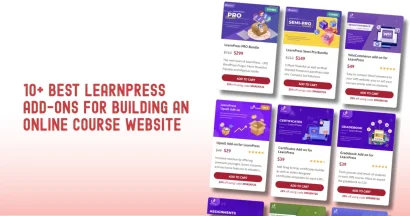Are you still relying on outdated practices that are costly, time-consuming, and fail to engage your employees or students? If so, it’s time to embrace the future of learning with learning management software (LMS).
Learning management software is revolutionizing how organizations deliver and manage training, offering a dynamic and efficient alternative to traditional methods.
But with so many different sorts of learning management software available, how do you choose the right one for your needs?
This article will walk you through everything you need to know about LMS, from the basics to advanced features, helping you find the best software for your specific needs. For a deeper understanding, explore the differences between LMS and eLearning platforms.
Let’s get started!
Eduma – Education WordPress Theme
We provide an amazing WordPress theme with fast and responsive designs. Let’s find out!
What is Learning Management Software?
In its simplest form, learning management software is a software application used to plan, implement, and assess a specific learning process. It’s a digital learning environment that offers a range of functionalities, including:
- Content creation and delivery: Create and upload various learning materials, such as videos, presentations, documents, and interactive quizzes.
- Progress tracking and assessment: Monitor learner progress, track course completion, and assess performance through quizzes, assignments, and automated grading.
- Communication and collaboration: Facilitate interaction between learners and instructors through forums, chat features, and online discussions.
- Reporting and analytics: Generate detailed reports on learner activity, performance, and overall program effectiveness.
Different Sorts of Learning Management Software
Not all learning management systems are created equal. They come in various forms, each with its own set of advantages and disadvantages:
- Cloud-based LMS: Hosted on the provider’s servers and accessed via the Internet. Offers scalability, affordability, and easy accessibility.
- On-premise LMS: Installed and maintained on your servers, providing greater control and customization but requiring IT infrastructure and expertise.
- Open-source LMS: Free to use and modify, offering flexibility and community support but potentially requiring technical skills for customization.
- Mobile LMS: Optimized for mobile devices, allowing learners to access training materials anytime, anywhere.
Best Learning Management Software Solutions
With a plethora of LMS options available, choosing the right one can be overwhelming. Here’s a curated list of some of the best learning management software solutions for different needs:
Thinkific
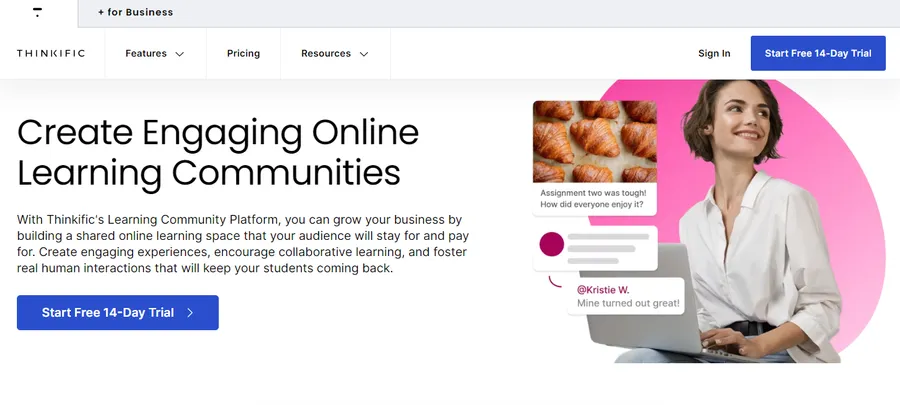
Thinkific is a popular cloud-based LMS platform specifically designed for entrepreneurs, creators, and businesses who want to create, market, and sell online courses. It’s known for its user-friendly interface, robust course creation tools, and built-in marketing features. Thinkific allows you to build a customized learning environment with your own branding, giving you full control over the student experience.
Key Features:
- Drag-and-drop course builder
- Multimedia support (video, audio, text, downloads)
- Quizzes and assessments
- Student progress tracking
- Certificates of completion
- Integrated marketing and sales tools (e.g., email marketing, coupons, upselling)
- Website and landing page builder
- Community features (e.g., discussion forums)
TalentLMS
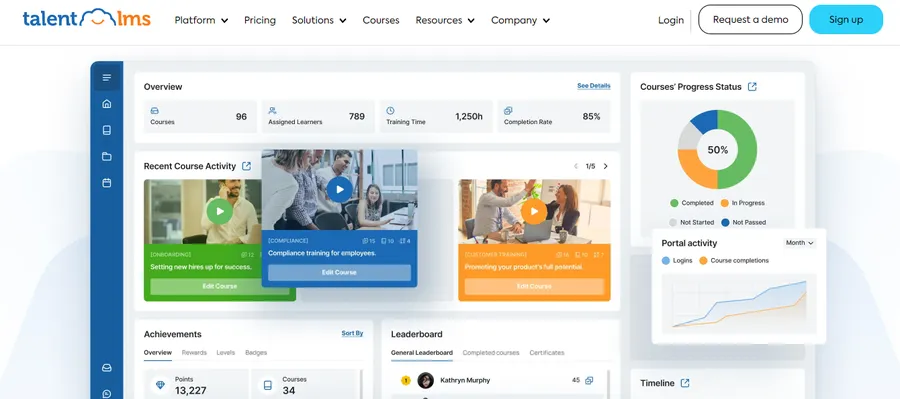
TalentLMS is a cloud-based LMS that focuses on employee training and development. It’s highly regarded for its ease of use, affordability, and gamification features that boost learner engagement. TalentLMS is a good option for businesses of all sizes, but it’s particularly well-suited for small to medium-sized businesses that need a straightforward and efficient training solution.
Key Features:
- Intuitive drag-and-drop interface
- Gamification (points, badges, leaderboards)
- Mobile learning app
- Built-in course authoring tools
- Assessment and surveys
- Reporting and analytics
- Integrations with popular business tools (e.g., Zoom, Salesforce)
Canvas LMS
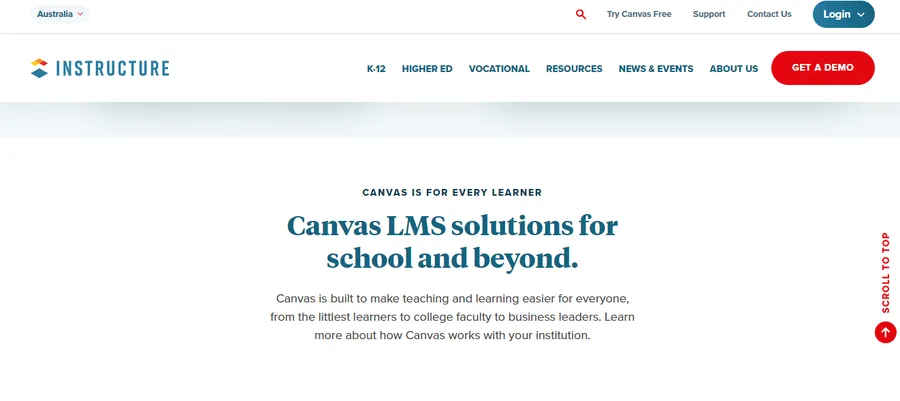
Canvas LMS is a comprehensive learning management system used by educational institutions worldwide, from K-12 schools to universities. It’s known for its open architecture, mobile accessibility, and focus on student engagement and collaboration. Canvas LMS provides a robust platform for educators to create dynamic learning experiences and manage all aspects of their courses.
Key Features:
- Course creation and organization tools
- Mobile app for students and instructors
- Communication and collaboration tools (e.g., discussion forums, video conferencing)
- Assessment and grading features
- Analytics and reporting
- Integration with third-party educational tools
Moodle
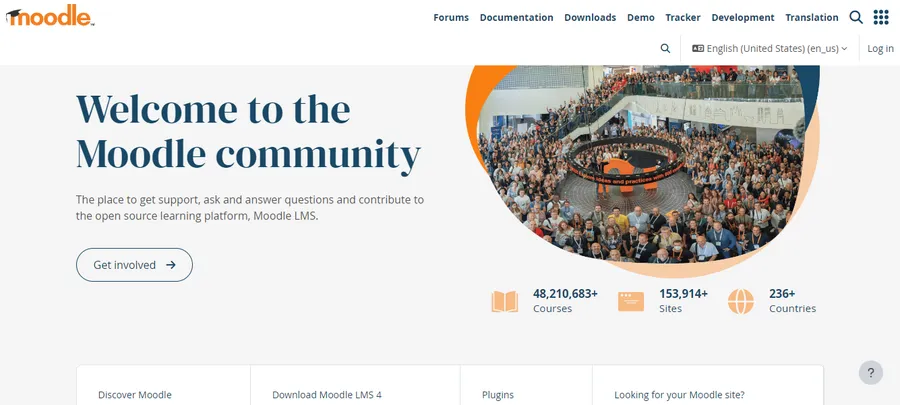
Moodle is a highly popular open-source LMS platform that’s widely used by educational institutions (K-12 and higher education) and organizations worldwide. It’s known for its flexibility, customization options, and active community support. Moodle allows you to create a tailored learning environment that meets your specific needs and offers a wide range of features for course management, assessment, and collaboration.
Key Features:
- Course creation and organization tools
- Variety of activity modules (forums, quizzes, assignments, wikis)
- Progress tracking and reporting
- Gradebook and assessment tools
- Communication tools (forums, messaging)
- Mobile app
- Extensive plugin library for added functionality
Docebo
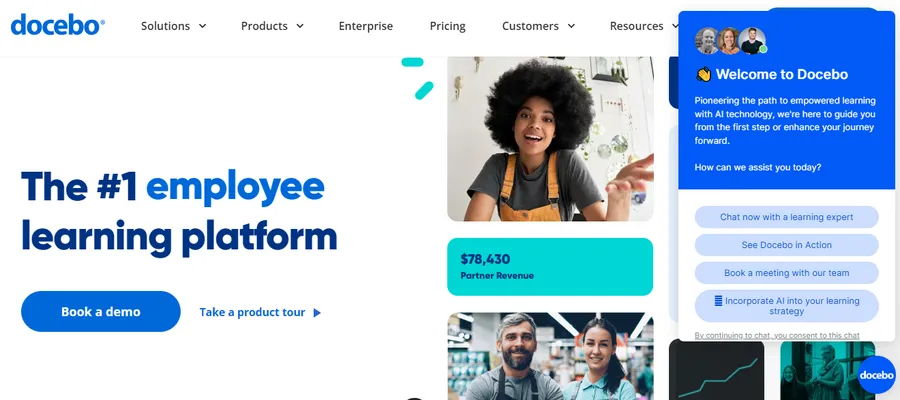
Docebo is a powerful cloud-based LMS designed for businesses of all sizes, with a focus on enterprise-level learning and development. It’s known for its AI-powered features, personalized learning paths, and social learning capabilities. Docebo offers a comprehensive suite of tools for creating, delivering, and managing training programs, making it a good choice for organizations looking to streamline their learning and development initiatives.
Key Features:
- AI-powered learning personalization
- Social learning tools (forums, knowledge sharing)
- Gamification and engagement features
- Skills management and development
- Advanced reporting and analytics
- Mobile learning app
- Integrations with HR and business systems
iSpring Learn
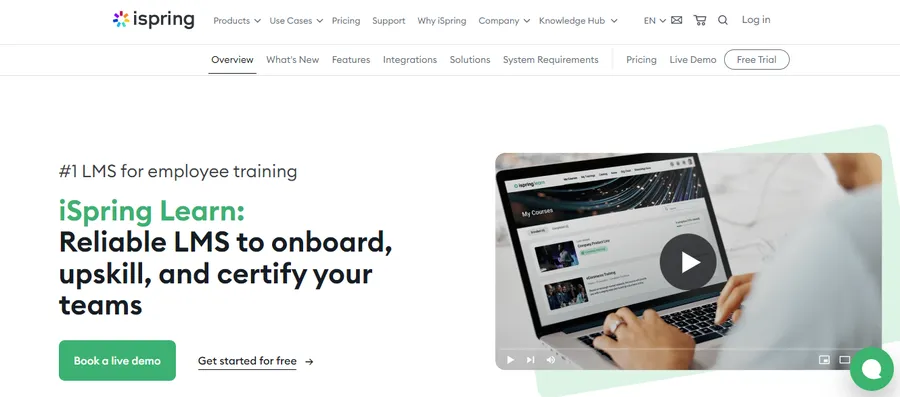
iSpring Learn is a cloud-based LMS that prioritizes ease of use and seamless content creation. It’s particularly well-suited for businesses that need a straightforward platform for delivering training materials, onboarding employees, and tracking progress. iSpring Learn integrates seamlessly with iSpring Suite, a powerful authoring tool for creating interactive eLearning content.
Key Features:
- Intuitive user interface
- Easy content upload and management
- Mobile learning app
- Gamification features
- Assessment and surveys
- Reporting and analytics
- Integration with iSpring Suite and other authoring tools
Key Features to Look for in an LMS
When evaluating different learning management system software, consider these essential features:
- Content creation tools: Look for an LMS that allows you to easily create and upload various types of content, including videos, presentations, and interactive exercises.
- Assessment options: Choose an LMS with a variety of assessment tools, such as quizzes, assignments, and surveys, to effectively measure learner understanding.
- Reporting and analytics: Ensure the LMS provides comprehensive reporting and analytics to track learner progress, identify areas for improvement, and measure the effectiveness of your training programs.
- Mobile compatibility: In today’s mobile-first world, it’s crucial to choose an LMS that’s accessible on various devices, including smartphones and tablets.
- Integrations: Check if the LMS integrates with other business tools you use, such as CRM, HR systems, and video conferencing platforms. For instance, LearnPress offers various integrations to enhance your eLearning platform’s capabilities.
Additionally, consider reading about the 9 Best WordPress LMS Plugins: Reviews and Comparisons to find the plugin that best fits your needs.
Benefits of Using Learning Management Software
Implementing an LMS can bring numerous benefits to your organization:
- Improved employee engagement and knowledge retention: Interactive learning materials and personalized learning paths can significantly boost learner engagement and knowledge retention.
- Reduced training costs: Eliminate the need for expensive travel, printed materials, and physical classroom space.
- Increased efficiency and productivity: Streamline training processes, automate tasks, and provide learners with on-demand access to learning materials.
- Enhanced compliance training: Ensure employees complete mandatory compliance training and track their progress efficiently.
- Scalability and flexibility: Easily scale your training programs to accommodate a growing workforce or changing business needs.
How to Choose the Right Learning Management Software
Selecting the best learning management software for your organization requires careful consideration. Follow these steps to make an informed decision:
- Assess your needs: Identify your specific training goals, target audience, and budget.
- Research different LMS options: Explore various LMS providers, compare features, and read reviews.
- Request demos and trials: Test out different LMS platforms to get a feel for their user interface and functionality.
- Consider vendor support: Ensure the LMS provider offers adequate support and resources to help you get started and address any issues.
Conclusion
Learning management software has become an indispensable tool for organizations of all sizes. By leveraging the power of LMS, you can enhance your training programs, improve employee engagement, and achieve your business goals. Take the time to research different options, choose the best fit for your needs, and unlock the full potential of online learning.
Read more:
12+ Best Online Course WordPress Plugins
5+ Best Strategies for Building Community in Online Courses
8 Best Social Media Marketing Tools for Businesses
Contact US | ThimPress:
Website: https://thimpress.com/
Fanpage: https://www.facebook.com/ThimPress
YouTube: https://www.youtube.com/c/ThimPressDesign
Twitter (X): https://twitter.com/thimpress

